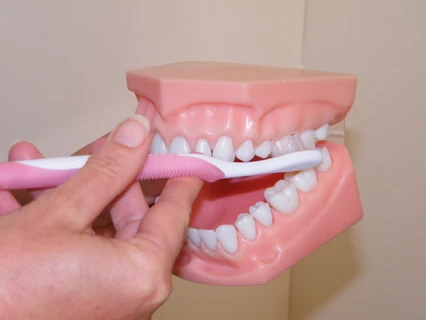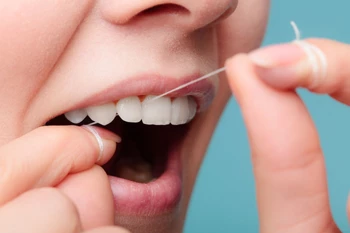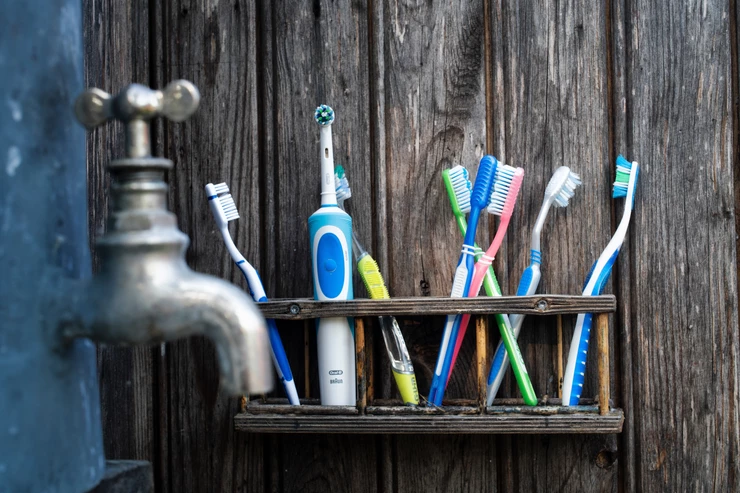There are many toothbrushes available that are designed to remove harmful bacteria known as plaque from your teeth. No matter which toothbrush you choose, your brushing technique will always be the most important factor.
The correct brushing technique is achieved by holding the toothbrush so the bristles sit at a 45° angle to the gum line. With a manual toothbrush use a gentle circular motion to brush the outside and inside surface of each tooth. Move your toothbrush slowly from tooth to tooth in a systematic fashion to remove plaque sitting along the gum line. We focus on the area near the gum line as this is where plaque begins to form. Once you have thoroughly cleaned the outside and inside surface of your teeth near the gum line you then clean the chewing surface of your teeth with back and forth strokes. If you are using an electric toothbrush let the rotating head do the work. Once again angle the bristles at 45° to the gum line, then slowly move the rotating head from tooth to tooth followed by the chewing surface. Always start in one area and work your way around systematically. Finish by brushing your tongue to remove odour causing bacteria.
You can achieve the same results with either a manual or an electric toothbrush if the proper brushing technique is used. However, if you are finding it difficult to clean thoroughly with a manual toothbrush switch to an electric toothbrush. The cheek side surface of your molars, and the tongue side of your lower anterior teeth are hard to reach areas. The small head of an electric toothbrush might be a better option. Parents cleaning young children’s teeth might find an electric toothbrush easier than a manual toothbrush.
No matter which toothbrush you prefer to use it is important that the bristles are soft and you don’t apply too much pressure. Brushing too hard will cause gum recession and tooth brush abrasion. Brushing cleans the outside surface of your teeth only leaving between your teeth to be cleaned.
Flossing cleans the areas between your teeth where your toothbrush can’t reach. Not only does flossing prevent decay developing in between your teeth it also keeps your gums healthy. To floss thoroughly it is important to curve the floss around the base of each tooth, making sure you go gently beneath the gumline. Move the floss up and down to gently scrap the side surface of each tooth. Remember to clean the back surface on your rear molar teeth. Even if you have widely spaced teeth, plaque still forms between them and below the gum line.
There’s a wide variety of floss available so it’s important to find one that suits you. Dental tape is flatter and a little wider than regular floss making it better suited for slightly larger spaces. Waxed floss is designed
to glide easier between tight spaces than non-waxed floss. If you have trouble holding or using floss, you might find a dental flossette easier to manage. Super floss is designed with a stiffened end to enter between your teeth, near the gumline. This is necessary if you have braces, orthodontic retainer or bridge work that prevents normal flossing. Don’t be alarmed if your gums bleed initially as this is quite common. Bleeding might be a sign that you have some form of gum disease. After a few days of proper flossing, the bleeding should stop.
Your dentist may recommend an interdental brush to assist with cleaning between your teeth and maintaining healthy gums. Interdental brushes are available in a variety of sizes and are often recommended to clean areas that are showing signs of gum inflammation or to clean around orthodontic appliances.
Oral irrigation systems such as the air flosser or water pick are both designed to remove plaque and food debris between teeth and below the gum line. The air flosser uses mostly air pressure and some droplets of water while the water flosser uses water pressure and pulsation.

Tooth brushing instructions
- Brush your teeth twice a day using a soft bristled toothbrush and a pea-sized amount toothpaste that contains fluoride
- Always brush systematically so you thoroughly clean all surfaces of your teeth (example: you may like to start on the upper right back teeth and work your way clock wise around your mouth).
- Hold the brush at a 45° angle towards the gum line and use a gentle circular motion to brush the outside and inside surfaces of each tooth.
- Use back and forth strokes on the chewing surfaces.
- Use the tip of the brush to brush behind your front teeth, both top and bottom using a flicking motion.
- Brush your tongue from back to front to remove odour-producing bacteria.
- Finish with a spit, not a rinse.
- Replace your brush at the first sign of wear or every three months.
Flossing instructions
- Floss your teeth daily, preferably at night
- Starting with about 45 cm of floss, wind most of the floss around each middle finger, leaving about 2cm of floss to work with.
- Holding the floss taut between your thumbs and index fingers, insert the floss gently between your teeth using a back and forth motion to avoid traumatising the gums.
- Gently curve the floss around the base of each tooth, making sure you go gently beneath the gumline. Move the floss up and down to gently scrap the side surface of each tooth.
- To remove the floss, use the same back-and-forth motion to bring the floss up through the contact point of your teeth.
- Use clean sections of floss as you move from tooth to tooth.
- Remember to clean the back surface on your rear molars.

Thank you for reading our blog. If you have had a positive experience at our practice and would like to tell us and others about it, you can click here to review us on Google or Facebook. You can also choose to send us an email with your feedback. Your positive reviews contribute greatly to a small business like ours.








